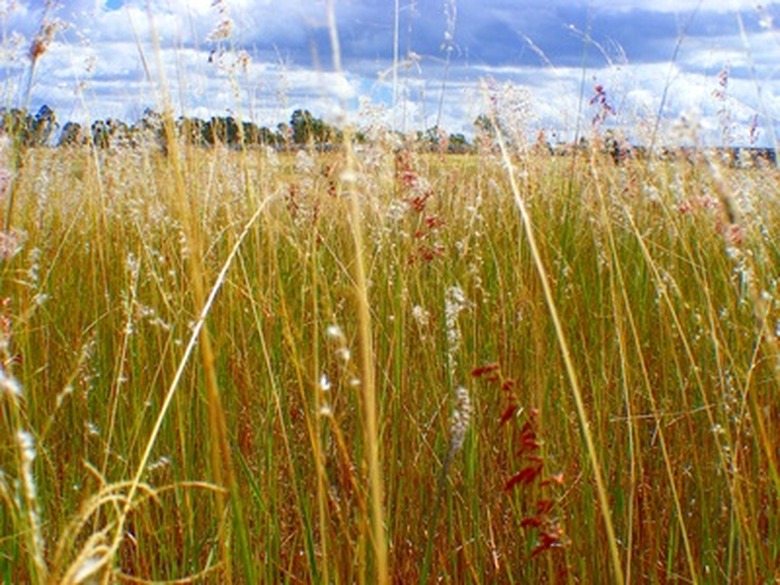Types Of Grass In The Grassland
Two types of grass grow in the world's grasslands: tall grass and short grass. The grasses grow in either tropical grasslands, also known as savannas, or in temperate grasslands. Temperate grasslands consist of prairies or steppes. Grasses that require more moisture grow in the prairies while grasses adapted to dry, arid conditions grow on the steppe.
Big Bluestem
Also known as turkey foot, big bluestem (Andropogon gerardii) remains a tall grass of the temperate grasslands. Growing up to 6 feet in height, the perennial grass features stems with a light brown to bronze color that starts in the fall and lasts into winter. The plant blooms in August and September. Big bluestem prefers moist, well-drained soil in full sun, but its deep roots allow it to also grow in hot, dry sites.
- Two types of grass grow in the world's grasslands: tall grass and short grass.
- The grasses grow in either tropical grasslands, also known as savannas, or in temperate grasslands.
Switchgrass
Growing up to 7 feet in height, switchgrass (Panicum virgatum) grows in the tall grass prairies. Switchgrass blooms from July to September, producing reddish seeds that help the plant reproduce. In the fall, the grass turns shades of golden yellow or bronze. Switchgrass grows best in full sun in moist, well-drained soil, although its high drought tolerance allows it to grow in much drier areas as well. Birds rely on the plant for food and shelter.
Blue Gama
Blue gama grass (Bouteloua gracilis) provides an important wildlife forage grass on the steppe grasslands. Growing up to 14 inches in height, the short grass flowers from July through October, producing bluish-green seed heads that resemble little brushes suspended from the tip of each stem. The perennial grass prefers full sun, growing in a variety of well-drained soils with low organic content including gravel or sandy loams.
- Growing up to 7 feet in height, switchgrass (Panicum virgatum) grows in the tall grass prairies.
- Switchgrass blooms from July to September, producing reddish seeds that help the plant reproduce.
Buffalo Grass
Found in both prairies and steppes, buffalo grass (Buchloe dactyloides) grows up to 10 inches high. The native perennial grass primarily grows on the Great Plains where it used to support buffalo herds. Buffalo grass grows best in heavy clay soils with moderate to low rainfall and plenty of sun.
Rhodes Grass
Rhodes grass (Chloris gayana) grows on the savanna where it reaches up to 5 feet in height. The plant produces spikes that turn copper-brown when mature. Drought tolerant, Rhodes grass grows in areas where rainfall ranges from 23 to 63 inches annually. The relatively drought-resistant plant thrives in full sun, growing in a range of soils. Outside the savanna, Rhodes grass is considered an invasive weed.
- Found in both prairies and steppes, buffalo grass (Buchloe dactyloides) grows up to 10 inches high.
Red Oat Grass
Also known as kangaroo grass or bluegrass, red oat grass (Themeda triandra) grows up to 3 feet in height on the savannas. When the grass reaches the end of its growing cycle, it turns a a golden-yellow color, sporting flattened seed pods that resemble fans. Red oat grass contains little nutritive value for wildlife, but the grass gets put to use in building materials such as thatched roofs.
